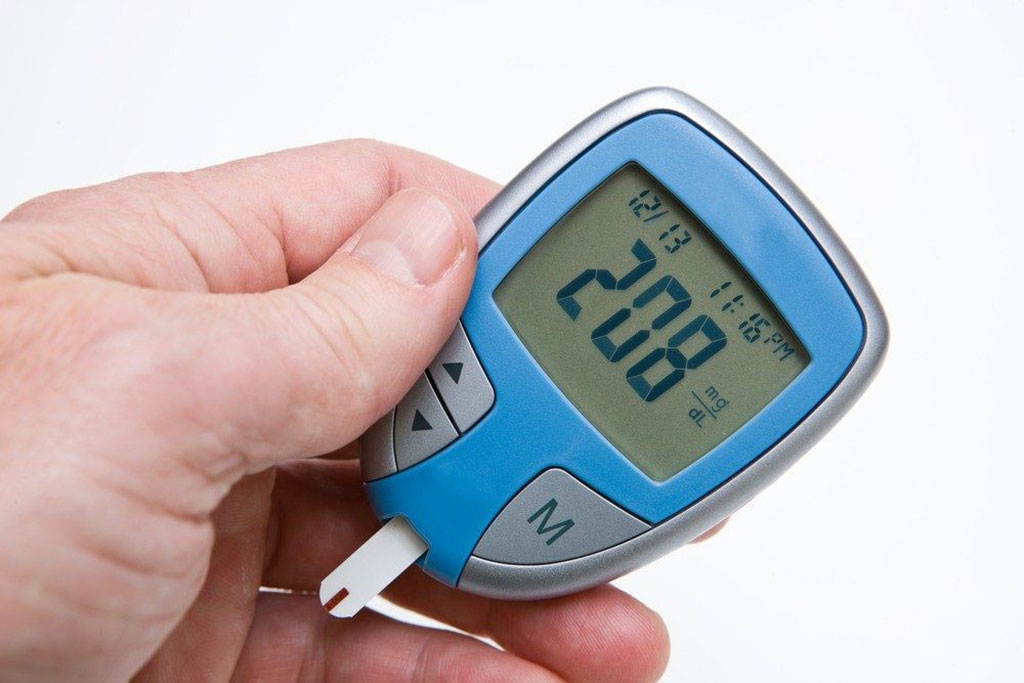Hyperglycemia and Hypoglycemia Associated with Poor Outcomes in COVID-19 Patients
By LabMedica International staff writers
Posted on 28 Dec 2020
Diabetes and hyperglycemia have emerged as important risk factors for hospitalization, disease severity, acute kidney injury, acute respiratory distress syndrome, intensive care unit (ICU) admissions, and death in patients with coronavirus disease 2019 (COVID-19).Posted on 28 Dec 2020
Hypoglycemia, also called low blood glucose or low blood sugar, occurs when the level of glucose in the blood drops below normal. Hyperglycemia is defined as having an abnormally high blood glucose. This condition is more common in Type 2, or non-insulin-dependent diabetics. It can also occur in Type 1 diabetics who consume carbohydrate-heavy foods without enough insulin afterwards.

Image: Blood glucose monitor showing a higher than normal result that could lead to hyperglycemia (Photo courtesy of Diabetes Self-Management).
A team of scientists working with the Mills-Peninsula Medical Center (San Mateo, CA, USA) analyzed pooled data from the Glytec national database (Waltham, MA, USA) including 1,544 patients with COVID-19 from 91 hospitals in 12 states. Patients were stratified according to achieved mean glucose category in mg/dL (≤7.77, 7.83–10, 10.1–13.88, and >13.88 mmol/L; ≤140, 141–180, 181–250, and >250 mg/dL) during days 2–3 in non-ICU patients or on day 2 in ICU patients. The team conducted a survival analysis to determine the association between glucose category and hospital mortality.
The investigators reported that in non-ICU patients, severe hyperglycemia (blood glucose ≥250 mg/dL) on days 2 to 3 was independently associated with high mortality (adjusted hazard ratio [aHR] = 7.17) compared with patients with blood glucose <140 mg/dL. This relationship was not significant for admission glucose (HR = 1.465). In patients admitted directly to the ICU, severe hyperglycemia on admission was associated with increased mortality (aHR = 3.14). This relationship was not significant on day 2 (HR = 1.40). Hypoglycemia (blood glucose <70 mg/dL) was also associated with increased mortality (odds ratio = 2.2). Of the patients, 279 (18.1%) died in the hospital. The mortality for ICU patients (31%) was almost twice that in the non-ICU population (16%).
Of the non-ICU patients, 40% had diabetes and average admission blood glucose level was 159.5 ± 78.6 mg/dL. The incidence of adverse outcomes included transfer to the ICU (34%), hypoglycemia (20%), acute kidney injury (21%), and mortality (16%). The median length of stay was 7.87 days before discharge or death, and the median time from admission to ICU transfer was 2.24 days for the 34% who transferred to the ICU. Of the ICU patients, 40% had diabetes and the average blood glucose level was 181.3 ± 105.6 mg/dL. The incidence of adverse outcomes included hypoglycemia (20%), acute kidney injury (27%), and mortality (31%). The median length of stay was 9.06 days before discharge or death.
David C. Klonoff, MD, an Endocrinologist and the lead author of the study, said, “The greater survival of the individuals with better control after admission compared with patients with uncontrolled glucose levels is clinically meaningful and indicates the need to start treatment of hyperglycemia on admission.” The study was published on December 15, 2020 in the journal Diabetes Care.
Related Links:
Mills-Peninsula Medical Center
Glytec














